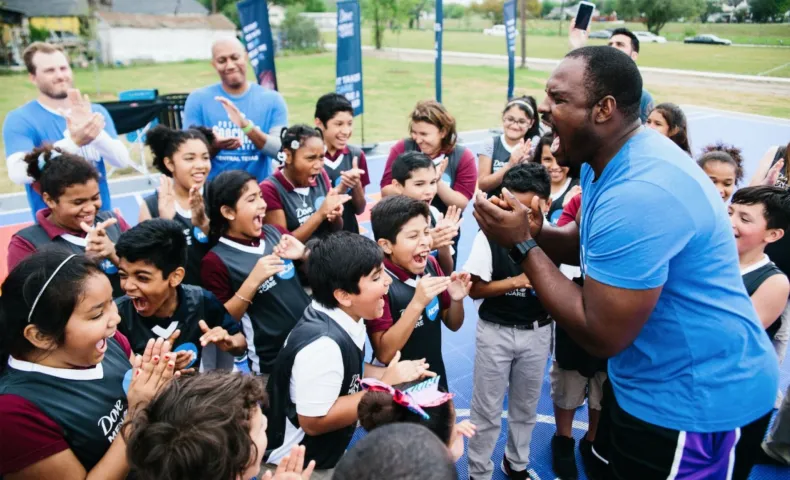 Photo Courtesy of Positive Coaching Alliance
Photo Courtesy of Positive Coaching Alliance
Lessons From A Successful Nonprofit Merger
Our President Cathy Cha currently serves on the board of the Positive Coaching Alliance.
Compared to the for-profit sector, the nonprofit world tends to view organizational mergers through a more skeptical lens. A nonprofit merger is often seen as something that happens when there’s a problem—like when one of the merging groups is facing a financial issue. There can also be a resistance to mergers among nonprofit leaders and boards who have forged a deep attachment to their organization and its mission and don’t want to see things change. As a result, nonprofit mergers are few and far between.
But the truth is, merging can also be viewed as a strategic way for strong nonprofits to grow even stronger and have greater community impact. And if done thoughtfully and well, the upsides of merging outweigh the downsides. That’s what we observed when a longtime grantee partner of the Haas, Jr. Fund recently merged with another organization and we learned some lessons along the way.
The Haas, Jr. Fund founded Coaching Corps in 2012 to help bring skilled coaches and positive sports opportunities to young people in under-resourced communities. In 2021, Coaching Corps decided to merge with Positive Coaching Alliance (PCA), a larger organization with a national footprint and broader reach.
Fast forward to now and the merged organization, which kept the Positive Coaching Alliance name, is firmly on track to expand and sharpen its programming, partnerships, and fundraising, with the goal of providing seven million young people with the transformational benefits of a positive, accessible sports experience in the next five years. And thanks to Coaching Corps’ equity-focused lens and expertise in underserved communities, the organization is making new inroads in expanding its services through school districts and community groups.
Willa Seldon, a partner in the consulting firm Bridgespan’s San Francisco office, said the PCA-Coaching Corps merger shows why and how mergers can add value and impact to nonprofit organizations in the right situations, especially at a time when the sector is seeking to scale solutions to so many seemingly intractable challenges facing communities. “The idea of moving more rapidly to scale and going to the next level in delivering on your mission and strategies can be a powerful incentive to merge,” said Seldon.
In the case of Coaching Corps and PCA, Seldon and her Bridgespan colleague, Laura Lanzerotti, said the conditions were just right to consider merging. “This is a case where you had an organization (Coaching Corps) really wanting to scale up, there was a willing and ready partner in PCA, and you had the leadership in place to make it happen,” said Lanzerotti, who was advising Coaching Corps on organizational strategy prior to the merger.
I recently spoke with the two amazing staff leaders who piloted the PCA-Coaching Corps merger: Janet Carter, the former longtime CEO of Coaching Corps who now is CEO of PCA; and Jason Sacks, who became president of PCA in 2022 after serving in a number of roles in the organization since 2006. Our conversation focused on their experience and what they learned.
A “Bigger Faster” Rationale for Merging
Janet Carter: At Coaching Corps, we had recently finished a strategic plan where we concluded we wanted to get bigger faster. We wanted to expand our reach into more underserved communities, grow our donor base, and increase the number of young people and coaches and families we could serve. Merging with an established organization with a respected brand and national footprint made perfect sense.
Jason Sacks: PCA was in a similar place. We had experienced a transition from a founding executive director, and we were trying to figure out our next chapter post-Covid. We wanted to do more work in underserved communities, and we knew that was a core part of the Coaching Corps mission. We saw pretty clearly that a merger would help us get where we wanted much faster than we could on our own.
The Power of Communications
Jason: When we first started talking about this, some people inevitably felt a sense of loss. You have to deal with that. I ended up having to do what I called “mythbuster” presentations and help people see that the merger was going to make us more effective and more impactful across the board.
Janet: Messaging was such a huge part of this. Jason and I each were very deliberate about crediting the legacy and the impact of the other organization and what it brought to the merger. We wanted to make sure there was no doubt that the two of us were unwavering in our support for this, and that we both saw this as an absolute win-win.
Bringing Funders Along
Janet: As we were considering the idea, we held confidential conversations with funders to ask their opinion and get feedback. We explained how we believed merging would get us where we wanted, and we tried to connect it to what funders had already told us they wanted for our organizations, which was bigger impact and broader reach.
Jason: I think one thing Janet and I would do differently is in those early conversations with funders, we should have asked for added funding for the merger. Because doing this costs money. As it was, some people said they wanted to wait and see how things played out, and that made for some dicey times. It’s a delicate balance, but the more of a commitment you can get up front, the better off you will be as the merger moves forward.
Bridging Cultures
Janet: In real estate they say “location, location, location.” In mergers, we learned it is “culture, culture, culture.” We had to be super-intentional from the start about bringing the best aspects of both of our organizations together and creating the culture we wanted for PCA. That meant mobilizing our staff teams to help us define our values and to understand that what they do every day builds culture. This wasn’t going to work if Jason and I were somehow trying to impose an organizational culture on the merged organization. We had to go into this with the understanding that everyone is a culture creator, and everyone has a shared responsibility for making the merger work.
Building Staff and Board Buy-In
Jason: We had two board members from each organization serving on the merger committee, so they were building relationships and buy-in across the two boards from the start. And then we made a conscious decision to keep all board members from each organization post-merger. That meant we had a large board, but over time some people have left and we are intent on right-sizing the board further in the years ahead.
Janet: It was a similar approach with the staff. We made a commitment to keeping all staff from both organizations on board for a year after the merger. Obviously, we had a number of people in similar and redundant positions, so there was a fair amount of shifting of roles—and not everyone agreed with where they were placed. We lost some folks because of that, and then in the second year we made some hard staffing decisions and had to let some people go. Now we feel we have the team in place to push forward with what we want to do.
What’s In A Name?
Janet: I loved the old Coaching Corps name, but I had to help people see that someone in Illinois or Ohio doesn’t know what Coaching Corps is. PCA already had a national brand—and in fact, Coaching Corps was confused with PCA a lot before the merger. And so I kept making the case that we needed that brand identity to reach more kids and achieve the vision we had always had for Coaching Corps, and eventually people came around. One thing we did was keep the Coaching Corps whistle as the PCA logo, so that helped a bit too.
Where PCA Is Now
Jason: We would not have gotten where we are today without the merger. We have a new five-year plan for expanding our fundraising and impact, and we have buy-in from funders and the board and staff. It’s full steam ahead.
Janet: Totally agree. We are in a much stronger position today. The merger is going to enable us to reach millions more kids with programs that help them and their families and communities see the benefits of positive sports.
Tips for A Successful Merger
My conversation with Janet and Jason surfaced a number of insights about how organizations and their leaders can help ensure that a nonprofit merger is the way to go—and, if so, that it delivers win-win results for organizations and the communities they serve:
- Find synergies and play to strengths. Assess how a merger supports each organization to achieve its goals for bigger, faster, broader impact. PCA brought a national footprint and branding to the merger, while Coaching Corps was respected for its work in underserved communities.
- Consider smaller steps toward a merger first. If the readiness is not there to merge from the start, organizations can consider smaller steps to test and further alignment. Strategic partnerships on specific projects can help staff and boards see the possibilities in merging, as well as any challenges that might need to be resolved in the event of a merger.
- Communicate, communicate, communicate. Building buy-in and reducing resistance and a sense of loss among staff, board, and others is key. PCA and Coaching Corps addressed key concerns for all groups and constantly emphasized how the merger would create a stronger, more impactful organization.
- Plan the integration. Organizations should develop concrete plans for merging cultures, navigating staff and board changes, and other issues. Negotiating the details of culture, staff and board roles, technology, and other essentials ensures a thoughtful approach and fewer surprises that could derail progress.
- Build support from the inside out. The top executives of each organization should serve as powerful ambassadors for the merger, showing unwavering commitment and methodically building support among board, staff, funders, and other stakeholders.
- Engage funders early. Organizations should prioritize keeping current funders on board by engaging them in early conversations to get their advice and buy-in. PCA and Coaching Corps also suggest getting funder commitments to support additional merger costs up front.
